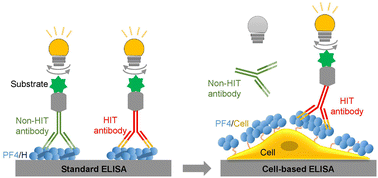Breast cancer cell-based ELISA: a potential material for better detection of heparin-induced thrombocytopenia antibodies†
Abstract
Heparin-induced thrombocytopenia (HIT) is caused by newly formed platelet-activating antibodies against complexes formed between platelet factor 4 (PF4) and heparin (H). HIT can result in life-threatening complications; thus, early detection of HIT antibodies is crucial for the treatment of the disease. The enzyme-linked immune absorbance assay (ELISA) for the identification of HIT antibodies is widely used in many laboratories, but in general, this test provides only ∼50% accuracy while other methods show multiple limitations. Here, we developed a new cell-based ELISA to improve the detection of HIT antibodies. Instead of immobilizing PF4 or PF4/H complexes directly onto a plate as in the standard ELISA, we added the complexes on breast cancer cells, i.e., cell line MDA-MB-231, and applied the same protocol for antibody detection. Using confocal laser scanning microscopy and flow cytometry for the characterization of bound complexes, we identified two types of HIT-mimicked antibodies (KKO and 1E12), which were able to differentiate from the non-HIT antibody (RTO). PF4-treated MDA-MB-231 cells allowed binding of HIT-mimicked antibodies better than PF4/H complexes. With human sera, the cell-based ELISA allowed better differentiation of clinically relevant from non-clinically relevant HIT antibodies as compared with the standard ELISA. Our findings provide a potential approach that contributes to the development of better assays for the detection of HIT antibodies.



 Please wait while we load your content...
Please wait while we load your content...